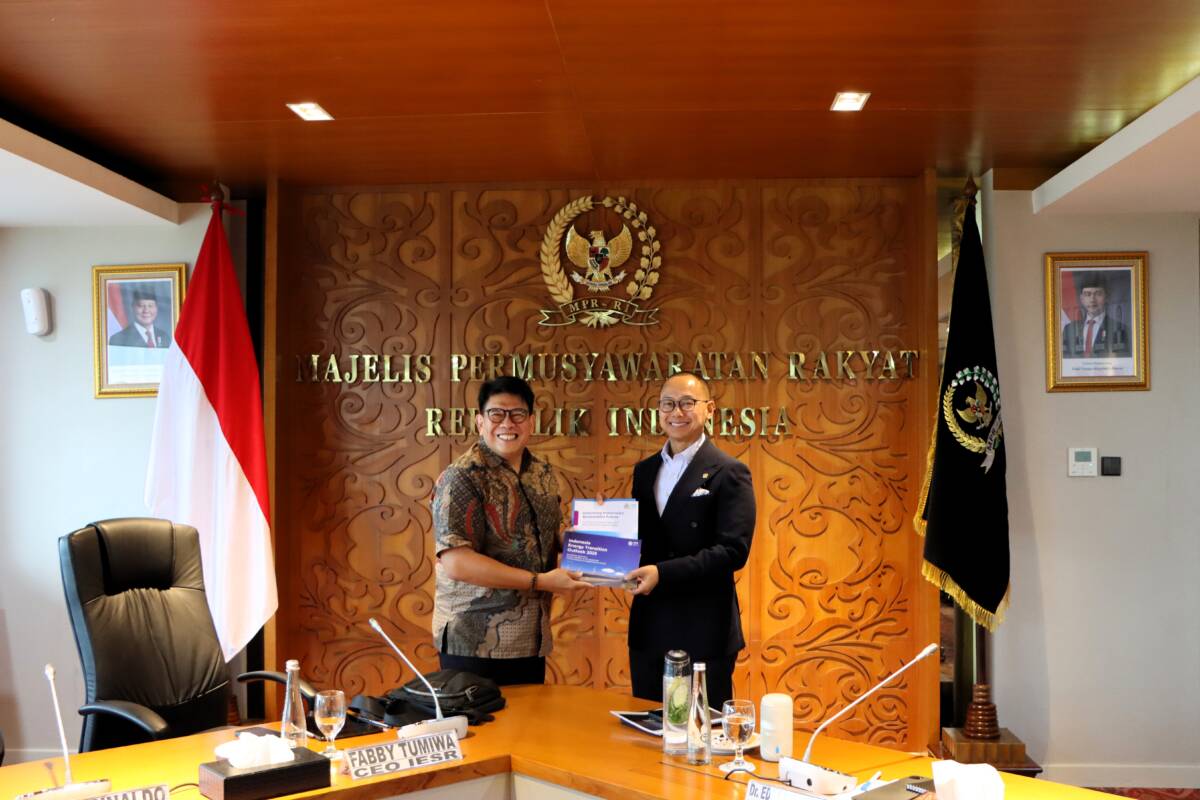Jakarta, August 11, 2025 – The Institute for Essential Services Reform (IESR) is urging that the Draft Law on New and Renewable Energy (EBET) and the Draft Law on Electricity can address Indonesia’s energy transition challenges and become an effective legal framework to accelerate the development of renewable energy. IESR hopes that these regulations can achieve energy independence, reduce greenhouse gas emissions, and increase access to green electricity for industries to enhance their competitiveness in the global market. They also aim to provide high-quality and affordable electricity for communities across Indonesia. IESR presented these views during an audience with Deputy Speaker of the MPR, Eddy Soeparno, at Nusantara III, the DPR/MPR Building, on Monday (11/8/2025).
IESR notes that based on data from the Ministry of Energy and Mineral Resources, the renewable energy mix only reached 15.37 percent by 2024. In the electricity sector, PLN, through its 2025–2034 Electricity Supply Business Plan (RUPTL), plans to add 69.5 GW of generation capacity, of which 42.6 GW will be renewable energy. This requires a total funding of Rp 1,682.4 trillion, with 80 percent of this amount involving private investment participation.
However, IESR observes that private investment interest in supporting the RUPTL’s implementation is not very good, reflecting on the realization of previous RUPTLs. Financial feasibility and bankable projects are factors contributing to low investor interest. These factors are influenced by PLN’s financial condition, where government-set electricity tariffs do not reflect the actual cost recovery and a reasonable margin for PLN. As a result, PLN makes various efforts to keep the Cost of Electricity Supply (BPP) low and demands that generation prices do not exceed the average BPP in the system.
IESR believes the need to procure around 4.26 GW of renewable energy generation annually will be a challenge for PLN, given that PLN’s current ability to procure renewable energy plants is still below 1 GW. Outdated electricity tariffs and procurement mechanisms result in low procurement performance for PLN. Consequently, the success rate for power plant procurement is below 30% of what was planned.
Moreover, one of the factors that the EBET and Electricity Draft Laws need to consider is the growing demand for renewable energy from industrial and business consumers. This sector is striving to increase export competitiveness and fulfill corporate social and environmental responsibilities in line with global demands for net-zero emissions.
“The availability of sufficient, easy, and affordable renewable energy is a prerequisite for industrial players to invest in Indonesia. Our investment competitiveness is also determined by the ease with which investors can access renewable energy. This needs to be understood by the government and the DPR,” said IESR CEO Fabby Tumiwa.
Fabby added that the need for clean energy and attracting investment has led neighboring countries like Malaysia and Vietnam to open their electricity grid access, allowing investors to purchase electricity directly from renewable energy developers. They use mechanisms such as power wheeling or Joint Use of Transmission Networks (PBJT) and direct power purchase agreements.
Therefore, IESR is pushing for the implementation of the PBJT mechanism and restructuring the electricity industry and market system in both draft laws, while still being in line with the 1945 Constitution. IESR believes that even though accelerating renewable energy development in Indonesia requires large investments and private participation, state control over electricity supply for the public interest must be maintained.
Energy System Transformation Program Manager, IESR, Deon Arinaldo, mentioned that an IESR study found Indonesia has 333 GW of economically viable renewable energy potential, based on the tariff rules of Presidential Regulation 112/2022 and common project financing structures in Indonesia. This potential consists of 165.9 GW of ground-mounted solar power plants, 167.0 GW of onshore wind power plants, and 0.7 GW of mini-hydro power plants. Furthermore, IESR also found that three islands in Indonesia—Bali, Sumbawa, and Timor—have the potential to be powered entirely by 100 percent renewable energy by 2050.
“The government needs to ensure that the PBJT mechanism is regulated and implemented, so that it becomes additional revenue for PLN and helps achieve the renewable energy development targets in the RUPTL and the RUKN vision,” Deon explained.
With limited fiscal space and the significant responsibility of PLN as a public service provider, a change in the structure of Indonesia’s electricity market is necessary. This includes changes within PLN itself to enable new business opportunities such as balancing or ancillary services.
In this audience, IESR provided three recommendations for the EBET Draft Law. First, to add a clause on the joint use of transmission networks (PBJT) as a solution to accelerate renewable energy development. Second, to set quotas within the PBJT scheme for renewable energy planning. Third, to regulate the role of individuals or communities to enable them to generate their own energy, promoting energy decentralization.
As for the recommendations for the Electricity Draft Law, IESR is pushing for six things. First, to transform and restructure the electricity industry and market in Indonesia. Second, to make the joint use of transmission networks (PBJT) part of the electricity market restructuring, through the options of either (i) forming a state-owned enterprise for transmission that is 100% state-owned; or (ii) forming a PLN subsidiary that is independent from PLN and focuses on managing and operating the transmission network.
Third, to require regulations to be an enabler for balancing and ancillary services in the electricity system. Fourth, to provide clarification on a Public Service Obligation (PSO) profit margin that is equivalent to global best practices for public utilities. Fifth, to include a clause regulating an independent supervisory or implementing body to conduct the renewable energy procurement process, including setting electricity tariffs and prices. Sixth, to provide guarantees for consumers who become prosumers in a modern electricity system.

